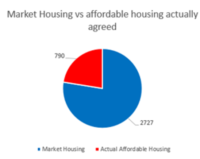Following the tragedy at Grenfell Tower the challenge of finding new homes for survivors has been thrown into the spotlight. A challenge that is exacerbated by the simple fact that in Kensington and Chelsea, as in areas across the country, there exists a huge shortage of affordable homes.
One reason for this is something regular readers of our blog will recognise: viability assessments.
Today we’ve released some new stats showing just how startling the problem in Kensington and Chelsea actually is.
What we found is that from 2009 – 2016 the Borough has lost out on at least 831 affordable homes that its own planning policies say should have been built.[1]
In total just 790 affordable homes were granted planning permission on the schemes that we researched while 2,727 private homes gained consent. That’s only 22% – despite local planning policy saying that 50% of homes on new developments should be affordable.

At a time of a national housing crisis we have to question a system that allows so many affordable homes to be lost.
What makes this even worse is that viability assessments are prepared by the developer’s own consultants, and are almost entirely secret. Most councils treat viability assessments as private, commercially confidential documents. Not only are they not seen by local communities but they aren’t even seen by elected councilors who sit on planning committees. This means all people know is that the developer has proved they can’t build affordable homes; they have no idea how these calculations have actually been done, and can’t challenge them.
What is viability?
Viability assessments – as the name suggests – are connected to how a housing development is judged to be financially ‘viable’. Or, to put it more simply, how it is calculated that a development will make the developer enough profit to be worth building.
Developers have a right to expect a return on their investment, and Shelter would never argue that they shouldn’t be properly paid for the work that they do. But the viability assessment process ensures a pretty high level of profit, and often at the expense of much needed affordable housing.
National planning policy essentially gives developers a right to a 20% profit on developments by guaranteeing them a ‘competitive return’ on investment. This means that if a developer can show that building the number of affordable homes required by local policy would reduce its profit below 20%, it can cut the amount of affordable housing. The result is that developers routinely lower the amount of affordable housing they build, while maintaining healthy profit margins.
This isn’t a problem confined to one area, it’s an issue we see happening all over the country in Manchester, Bristol, Birmingham and London.
What can we do?
Sometimes even simple problems require complex solutions, but this isn’t one of those issues. What we need is a combination of transparency and reform.
This means:
- Complete transparency of viability assessments– the government’s planning guidance should make clear that viability assessments will be considered public documents. We need to make sure that the viability process isn’t done behind closed doors, and that local councillors and local communities can understand why the developer is proposing to cut affordable homes, and can scrutinise the calculations behind this claim.
- Change the rules – specifically remove the sentence in government planning guidance that says developers are entitled to a ‘competitive return’, which is generally taken to mean 20%. If this were replaced with ‘a return’ then a site would be deemed viable if it generated a positive return – not an arbitrary profit level of 20%.
- Policy not targets – in all but the most exceptional circumstances affordable homes policy should be non-negotiable. These should not be considered by developers as ‘aspirational targets’ but rather cast iron policy based on proper calculations about local need. The result would be that developers would factor the costs into their plans from the start, rather than assuming that they will be able to negotiate them away later.
Promisingly, the government is already taking steps to make improvements in this area and recently announced a consultation that includes proposals for reforming viability.
This is really encouraging and shows that change is coming on this issue – and it can’t come soon enough. We desperately need to ensure that the affordable homes local areas need get built.
[1] Analysis of 96 planning applications provided by Kensington and Chelsea through a Freedom of Information request. On those 96 schemes 3,517 homes were given planning permission. Based on Kensington and Chelsea policy exactly 50% of those should have been affordable units, however, the actual overall percentage of affordable homes delivered was 22%. On sites where there was a viability assessment (44 of the 96) this number stands at 15%.
